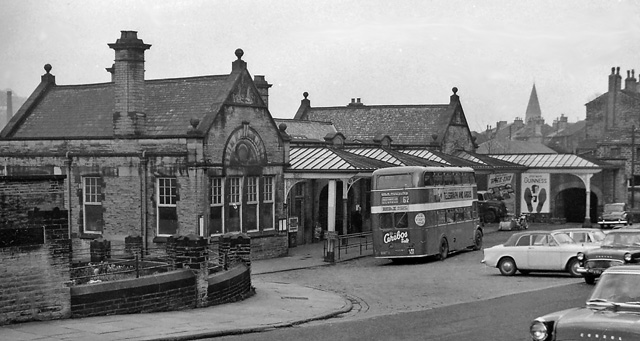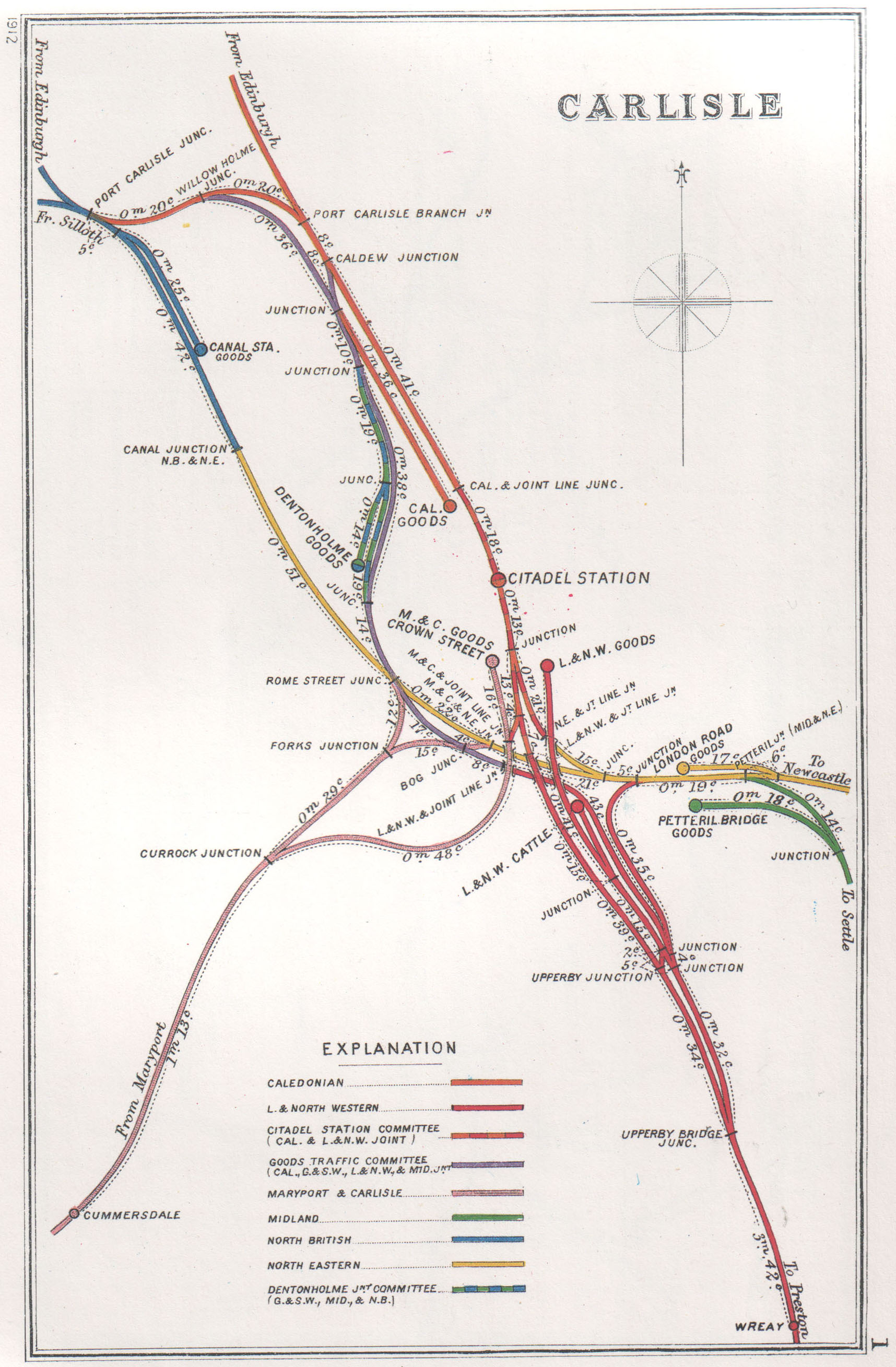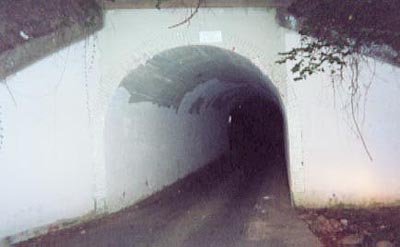|
Bingley Railway Station
Bingley railway station is a grade II listed railway station that serves the town of Bingley in West Yorkshire, England, and is away from Leeds and away from Bradford Forster Square on the Airedale line operated by Northern Trains. History The Leeds and Bradford Railway opened the Leeds and Bradford Extension Railway from Shipley to Keighley on 16 March 1847. Bingley station opened on the first day, and remained the only intermediate station until Saltaire was built in 1856. The original station was near the Three Rise Locks on the Leeds and Liverpool Canal, but the Midland Railway (who had absorbed the L&BR in 1851) closed the old station and opened the current station on 24 July 1892. The second station was designed by Charles Trubshaw, who was a Midland Railway architect. The goods yard and accompanying shed, were located to the north of the station on the down side of the running lines. The shed, which is now in private hands, was taken out of railway use in 1965 ... [...More Info...] [...Related Items...] OR: [Wikipedia] [Google] [Baidu] |
Bingley
Bingley is a market town and civil parish in the metropolitan borough of the City of Bradford, West Yorkshire, England, on the River Aire and the Leeds and Liverpool Canal, which had a population of 18,294 at the 2011 Census. Bingley railway station is in the town centre and Leeds Bradford International Airport is away. The B6265 connects Bingley to Keighley. Historically part of the West Riding of Yorkshire, Bingley appears in the ''Domesday Book'' of 1086 as "Bingheleia". History Founding Bingley was probably founded by the Saxons, by a ford on the River Aire. This crossing gave access to Harden, Cullingworth and Wilsden on the south side of the river. The origins of the name are from the Old English personal name ''Bynna'' + ''ingas'' ("descendants of") + ''lēah'' ("clearing in a forest"). This would mean altogether the "wood or clearing of the Bynningas, the people called after Bynna". Normans In the Domesday Book of 1086, Bingley is listed as "Bingheleia": ''m I ... [...More Info...] [...Related Items...] OR: [Wikipedia] [Google] [Baidu] |
Keighley Railway Station
Keighley railway station serves the town of Keighley in West Yorkshire, England. The station is located on the Airedale line, with electric services to , and provided by Northern, along with longer distance services to and . The station is split in half, with National Rail operating from platforms 1 and 2, while platforms 3 and 4 are the northern terminus of heritage services to on the Keighley & Worth Valley Railway. History Keighley station first opened on a site slightly further up the line in March 1847 by the Leeds and Bradford Extension Railway. The volume of traffic over the original level crossing in the town, prompted the Midland Railway, which had absorbed the LBER, to spend £60,000 in 1876 building the road bridge immediately to the north of where the present station is located. A new station was built south of this bridge in 1883–1885. The second station was designed by Charles Trubshaw, who was a Midland Railway architect. The station is located on the Air ... [...More Info...] [...Related Items...] OR: [Wikipedia] [Google] [Baidu] |
Carlisle Railway Station
Carlisle railway station, or Carlisle Citadel, is a Grade II* listed railway station serving the city of Carlisle, Cumbria, England. It is on the West Coast Main Line, south-east of and north north-west of . It is the northern terminus of the Settle and Carlisle Line, a continuation of the Midland Main Line from , and . It was formerly the southern terminus of the partially-closed Waverley Route from Edinburgh. It is so named because it is adjacent to Carlisle Citadel, a former medieval fortress. The station is owned by Network Rail. In September 1847, the first services departed the station, even though construction was not completed until the following year. It was built in a neo- Tudor style to the designs of English architect William Tite. Carlisle station was one of a number in the city; the others were Crown Street and London Road, but it became the dominant station by 1851. The other stations had their passenger services redirected to it and were closed. Between 1 ... [...More Info...] [...Related Items...] OR: [Wikipedia] [Google] [Baidu] |
Lancaster Railway Station
Lancaster may refer to: Lands and titles *The County Palatine of Lancaster, a synonym for Lancashire *Duchy of Lancaster, one of only two British royal duchies *Duke of Lancaster *Earl of Lancaster *House of Lancaster, a British royal dynasty Places Australia *Lancaster, Victoria Canada *Lancaster, New Brunswick *Lancaster, Newfoundland and Labrador * Lancaster, Ontario *Lancaster, St. Catharines, Ontario *Lancaster Sound, Nunavut United Kingdom *Lancaster, Lancashire, the original Lancaster from which other place names are derived **Lancaster University **Lancaster (UK Parliament constituency), a historical political district **Lancaster and Wyre (UK Parliament constituency), the modern political district **City of Lancaster, a non-metropolitan local government district based in Lancaster, formed in 1974 **Lancaster Rural District, a former local government area abolished in 1974 **Municipal Borough of Lancaster, a former local government area abolished in 1974 *Lancaster ... [...More Info...] [...Related Items...] OR: [Wikipedia] [Google] [Baidu] |
Lancashire Gazette
Lancashire ( , ; abbreviated Lancs) is the name of a Historic counties of England, historic county, Ceremonial County, ceremonial county, and non-metropolitan county in North West England. The boundaries of these three areas differ significantly. The non-metropolitan county of Lancashire was created by the Local Government Act 1972. It is administered by Lancashire County Council, based in Preston, Lancashire, Preston, and twelve district councils. Although Lancaster, Lancashire, Lancaster is still considered the county town, Preston is the administrative centre of the non-metropolitan county. The ceremonial county has the same boundaries except that it also includes Blackpool and Blackburn with Darwen, which are unitary authorities. The historic county of Lancashire is larger and includes the cities of Manchester and Liverpool as well as the Furness and Cartmel peninsulas, but excludes Bowland area of the West Riding of Yorkshire transferred to the non-metropolitan county ... [...More Info...] [...Related Items...] OR: [Wikipedia] [Google] [Baidu] |
Urban Legend
An urban legend (sometimes contemporary legend, modern legend, urban myth, or urban tale) is a genre of folklore comprising stories or fallacious claims circulated as true, especially as having happened to a "friend of a friend" or a family member, often with horrifying, humorous, or cautionary elements. These legends can be entertaining but often concern mysterious peril or troubling events, such as disappearances and strange objects or entities. Urban legends may confirm moral standards, reflect prejudices, or be a way to make sense of societal anxieties. Urban legends in the past were most often circulated orally, but now can also be spread by any media. This includes newspapers, mobile news apps, e-mail, and most often, social media. Some urban legends have passed through the years/decades with only minor changes, in where the time period takes place. Generic urban legends are often altered to suit regional variations, but the lesson or moral remains majorly the same. Or ... [...More Info...] [...Related Items...] OR: [Wikipedia] [Google] [Baidu] |
Bingley Grammar School
Bingley Grammar School (BGS) is a Voluntary aided school for students from the ages of 11–18 and is located on the outskirts of Bingley, West Yorkshire, England. Bingley Grammar School was a specialist school for Business & Enterprise from 2006 to 2011. Due to this, students had previously been required to take Business at GCSE but since the 2010 introduction of the English Baccalaureate this is now no longer mandatory. History Bingley Grammar School's long tradition stems from its foundation in 1529, when a series of wealthy benefactors from among the people of Bingley provided a trust to support the education of the young people of the town. As of 2007, the Foundation Trust Governors meet each term to manage the assets of the trust, and to ensure that the proceeds are used to enhance the education of pupils of the School, now back to its former 'Voluntary Aided' status. From 2006 to 2011 the school was a Business and Enterprise college, assisted mainly by the voluntary a ... [...More Info...] [...Related Items...] OR: [Wikipedia] [Google] [Baidu] |
Bradford Observer
Bradford is a city status in the United Kingdom, city and the administrative centre of the City of Bradford district in West Yorkshire, England. The city is in the Pennines' eastern foothills on the banks of the Bradford Beck. Bradford had a population of 349,561 at the 2011 Census for England and Wales, 2011 census; the second-largest population centre in the county after Leeds, which is to the east of the city. It shares West Yorkshire Built-up Area, a continuous built-up area with the towns of Shipley, West Yorkshire, Shipley, Silsden, Bingley and Keighley in the district as well as with the metropolitan county's other districts. Its name is also given to Bradford Beck. It became a West Riding of Yorkshire municipal borough in 1847 and received its city charter in 1897. Since Local Government Act 1972, local government reform in 1974, the city is the administrative centre of a wider metropolitan district, city hall is the meeting place of Bradford City Council. The district ... [...More Info...] [...Related Items...] OR: [Wikipedia] [Google] [Baidu] |
Bingley Tunnel
Bingley is a market town and civil parish in the metropolitan borough of the City of Bradford, West Yorkshire, England, on the River Aire and the Leeds and Liverpool Canal, which had a population of 18,294 at the 2011 Census. Bingley railway station is in the town centre and Leeds Bradford International Airport is away. The B6265 connects Bingley to Keighley. Historically part of the West Riding of Yorkshire, Bingley appears in the ''Domesday Book'' of 1086 as "Bingheleia". History Founding Bingley was probably founded by the Saxons, by a ford on the River Aire. This crossing gave access to Harden, Cullingworth and Wilsden on the south side of the river. The origins of the name are from the Old English personal name ''Bynna'' + ''ingas'' ("descendants of") + ''lēah'' ("clearing in a forest"). This would mean altogether the "wood or clearing of the Bynningas, the people called after Bynna". Normans In the Domesday Book of 1086, Bingley is listed as "Bingheleia": ''m In ... [...More Info...] [...Related Items...] OR: [Wikipedia] [Google] [Baidu] |
Charles Trubshaw
Charles Trubshaw FRIBA (1840 – 15 February 1917) was an architect specifically associated with railway buildings on the London and North Western Railway and Midland Railway lines. Career He trained as an architect in the office of his father, also Charles Trubshaw (1811–1862), a civil engineer and also county surveyor for Staffordshire.Midland Hotel, Bradford Charles Trubshaw, Architect He was appointed Associate of the on 6 February 1864, and Fellow of the Royal Institute of British Architects on 6 November 1882. He was on the engineering and architectural staff of the |
Midland Railway
The Midland Railway (MR) was a railway company in the United Kingdom from 1844. The Midland was one of the largest railway companies in Britain in the early 20th century, and the largest employer in Derby, where it had its headquarters. It amalgamated with several other railways to create the London, Midland and Scottish Railway at grouping in 1922. The Midland had a large network of lines emanating from Derby, stretching to London St Pancras, Manchester, Carlisle, Birmingham, and the South West. It expanded as much through acquisitions as by building its own lines. It also operated ships from Heysham in Lancashire to Douglas and Belfast. A large amount of the Midland's infrastructure remains in use and visible, such as the Midland main line and the Settle–Carlisle line, and some of its railway hotels still bear the name '' Midland Hotel''. History Origins The Midland Railway originated from 1832 in Leicestershire / Nottinghamshire, with the purpose of serving the needs o ... [...More Info...] [...Related Items...] OR: [Wikipedia] [Google] [Baidu] |
Leeds And Liverpool Canal
The Leeds and Liverpool Canal is a canal in Northern England, linking the cities of Leeds and Liverpool. Over a distance of , crossing the Pennines, and including 91 locks on the main line. The Leeds and Liverpool Canal has several small branches, and in the early 21st century a new link was constructed into the Liverpool docks system. History Background In the mid-18th century the growing towns of Yorkshire, including Leeds, Wakefield and Bradford, were trading increasingly. While the Aire and Calder Navigation improved links to the east for Leeds, links to the west were limited. Bradford merchants wanted to increase the supply of limestone to make lime for mortar and agriculture using coal from Bradford's collieries and to transport textiles to the Port of Liverpool. On the west coast, traders in the busy port of Liverpool wanted a cheap supply of coal for their shipping and manufacturing businesses and to tap the output from the industrial regions of Lancashire. Inspired by ... [...More Info...] [...Related Items...] OR: [Wikipedia] [Google] [Baidu] |








